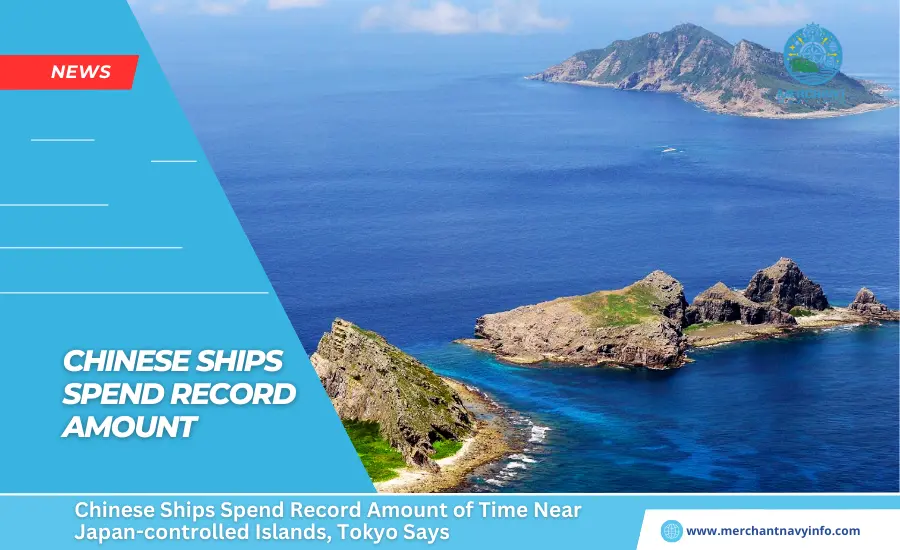
According to Tokyo’s latest count released Monday, Chinese ships have been in waters around Japanese-controlled islands in the East China Sea. This has been for 158 consecutive days, surpassing the previous record set in 2021.
Analysts fear the uninhabited islands, known as the Senkakus in Japan and the Diaoyus in China, could become a flashpoint for conflict between the two Asian neighbours.
“The Japanese government takes very seriously the fact that there have been a succession of vessels sailing in the contiguous zone. Also, trespassing in territorial waters,” Chief Cabinet Secretary Yoshimasa Hayashi said during a Monday briefing in Tokyo.
The Japanese government chief spokesperson did not say how often Chinese ships entered Japan’s territorial waters. Though foreign ships are allowed “innocent passage” through such waters.
A contiguous zone extends another 12 nautical miles beyond a country’s territorial waters, stretching 12 nautical miles from the shore.
Foreign warships are allowed into contiguous zone waters, so the Chinese Coast Guard hasn’t broken any international agreements. However, the continuous presence of Chinese vessels there is seen as a provocation.
Hayashi said Japanese Prime Minister Fumio Kishida has raised Tokyo’s “serious concerns” with Chinese Premier Li Gongmin. This was during a trilateral summit with South Korea in Seoul on Monday.
“We will continue to take every possible precaution and surveillance around the Senkaku Islands with a sense of urgency,” he said.
The uninhabited island chain has been a sore spot in Japan-China relations for years. Claims over the rocky chain, 1,200 miles (1,900 kilometres) southwest of Tokyo but only about 205 miles (330 kilometres) from China’s east coast. These date back centuries, and neither Japan nor China is likely to back down over territory. This considered a national birthright in both capitals.
Decades-Long Dispute Simmers Over Uninhabited Islands as Chinese Ships move around
Tensions heated up in 2012 after Tokyo purchased some of the islands from a private Japanese owner. This Beijing took as a direct challenge to its sovereignty claims.
It has frequently dispatched the China Coast Guard and other government vessels to the waters around the islands to assert those claims.
“China’s law enforcement and patrol missions in waters off the Diaoyu Dao are honest steps taken by China to practice its sovereignty by law. They are necessary responses to Japanese provocations in violation of China’s sovereignty,” a 2022 Chinese Foreign Ministry document says.
“No country or force should undervalue the strong resolve of the Chinese government to guard sovereignty and territorial integrity,” it says.
Experts have said that by keeping government ships near the islands, China made a statement and set up a possible legal argument for sovereignty over them.
To present an international legal suit to the islands over Japan, “China simply requires to establish a greater and permanent presence of its ships in the waters around the islands,” James Brown, an associate professor of political science at Temple University in Tokyo, told CNN in 2022.
Hayashi, the Japanese government spokesperson, said Monday that Tokyo is responding to the Chinese presence around the islands with its own vessels.
“We ensure a comprehensive security system for territorial waters by deploying Coast Guard patrol vessels. These are consistently superior to other party’s capacity,” Hayashi said.
Analysts note that any Japanese-Chinese incident in the Senkakus raises the risk of a wider conflict. This due to Japan’s mutual defence treaty with the United States.
Washington has repeatedly made clear that it considers the Senkakus to be covered by the mutual defense pact.
China’s Assertiveness Spans Multiple East Asian Fronts
The extended Chinese presence around the Senkakus. This comes as Chinese forces assert themselves in two other East Asian hotspots . One around Taiwan and near Philippines-controlled features in the South China Sea.
China staged its largest military exercises this year around Taiwan last week after the island’s new democratically elected leader, President Lai Ching-te. The new leader is openly hostile to China.
China’s ruling Communist Party says Taiwan is part of its territory. Despite never having controlled it, and has vowed to take the island by force if necessary.
In the South China Sea, the China Coast Guard has been taking action against Philippine vessels. This while they were trying to resupply a contingent of Philippine marines on the Second Thomas Shoal. The attack damaged the vessels and caused injuries.
The developments come as leaders and military officials prepare to gather in Singapore for the Shangri-La Dialogue. This is Asia’s premier defence summit.
Philippine President Ferdinand Marcos Jr. is scheduled to give the keynote speech Friday evening. Chinese-Philippine clashes around Second Thomas Shoal are expected to be a prime topic.
American and Chinese military leaders will also be in attendance.









